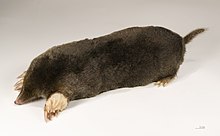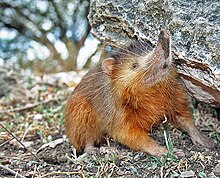Eulipotyphla
| Eulipotyphla Temporal range:
| |
|---|---|

| |
| Clockwise from upper left: a solenodon, hedgehog,[a] mole and shrew | |
| Scientific classification | |
| Domain: | Eukaryota |
| Kingdom: | Animalia |
| Phylum: | Chordata |
| Class: | Mammalia |
| Magnorder: | Boreoeutheria |
| Superorder: | Laurasiatheria |
| Order: | Eulipotyphla Waddell et al., 1999 |
| Families | |
| |
| Synonyms | |
| |
Eulipotyphla (/ˌjuːlɪpoʊˈtɪflə/, which means "truly fat and blind"[1]) is an order of mammals comprising the hedgehogs and gymnures; the solenodons; the moles, shrew-like moles and desmans; and true shrews. (These correspond to the four taxonomical families Erinaceidae, Solenodonstidae, Talpidae, and Soricidae, respectively.)
Historical classification
[edit]Historically, these animals were grouped with others such as treeshrews, elephant shrews, and colugos, under the broader catch-all category Insectivora. This now-abandoned category, consisting of all small insect-eating placental mammals, was based on physical appearance. But despite the fact that these animals share similar skeletal structures and occupy similar ecological niches, molecular studies gradually revealed that these similarities evolved separately, and were not a result of common ancestry. The group Insectivora was therefore split up and revised into groups with shared ancestry (monophyletic groups), one of which was Eulipotyphla.[2][3][4]
A 2023 study suggested that the order began to diversify prior to the K-Pg extinction, based on molecular clock estimates.[5]
Classification
[edit]



- Order Eulipotyphla (= 'Lipotyphla' - Afrosoricida = 'Erinaceomorpha' + 'Soricomorpha')
- Family Erinaceidae[8]
- Subfamily Erinaceinae: hedgehogs
- Subfamily Galericinae: gymnures or moonrats
- Family Soricidae[9]
- Subfamily Crocidurinae: white-toothed shrews
- Subfamily Soricinae: red-toothed shrews
- Subfamily Myosoricinae: African white-toothed shrews
- Family Talpidae[10]
- Subfamily Talpinae: Old World moles and desmans
- Subfamily Scalopinae: New World moles
- Subfamily Uropsilinae: shrew-like moles
- Family Solenodontidae: solenodons
- † Family Nesophontidae: extinct West Indian shrews
- † Family Amphilemuridae
- † Family Nyctitheriidae
- † Family Plesiosoricidae
- Family Erinaceidae[8]
Family-level cladogram of modern eulipotyphlan relationships, following Roca et al. and Brace et al.:[3][11]
| Eulipotyphla | |
The upper and lower basal subclades within the tree are the suborders Solenodonota and Erinaceota, respectively.[11] These two branches are estimated to have split ~72–74 million years (Ma) ago.[11][6][7] The Nesophontidae and Solenodontidae are thought to have separated roughly 57 Ma ago.[11] Split times for talpids vs. soricids plus erinaceids, and for soricids vs. erinaceids, have been estimated at 69 Ma and 64 Ma ago, respectively.[12]
Notes
[edit]- ^ Either a European hedgehog or a northern white-breasted hedgehog
References
[edit]- ^ Hassan, Mo (2009-10-11). "British Wildlife: N". The Disillusioned Taxonomist blog. Retrieved 2015-11-26.
- ^ Douady, C. J.; Chatelier, P. I.; Madsen, O.; de Jong, W. W.; Catzeflis, F.; Springer, M. S.; Stanhope, M. J. (October 2002). "Molecular phylogenetic evidence confirming the Eulipotyphla concept and in support of hedgehogs as the sister group to shrews". Molecular Phylogenetics and Evolution. 25 (1): 200–209. doi:10.1016/S1055-7903(02)00232-4. PMID 12383761.
- ^ a b Roca, A. L.; Bar-Gal, G. K.; Eizirik, E.; Helgen, K. M.; Maria, R.; Springer, M. S.; O'Brien, S. J.; Murphy, W. J. (2004-06-10). "Mesozoic origin for West Indian insectivores". Nature. 429 (6992): 649–651. Bibcode:2004Natur.429..649R. doi:10.1038/nature02597. PMID 15190349. S2CID 915633.
- ^ Bininda-Emonds, O. R. P.; Cardillo, M.; Jones, K. E.; MacPhee, R. D. E.; Beck, R. M. D.; Grenyer, R.; Price, S. A.; Vos, R. A.; Gittleman, J. L.; Purvis, A. (2007-03-29). "The delayed rise of present-day mammals". Nature. 446 (7135): 507–512. Bibcode:2007Natur.446..507B. doi:10.1038/nature05634. PMID 17392779. S2CID 4314965.
- ^ Foley, Nicole M.; Mason, Victor C.; Harris, Andrew J.; Bredemeyer, Kevin R.; Damas, Joana; Lewin, Harris A.; Eizirik, Eduardo; Gatesy, John; Karlsson, Elinor K.; Lindblad-Toh, Kerstin; Zoonomia Consortium‡; Springer, Mark S.; Murphy, William J.; Andrews, Gregory; Armstrong, Joel C. (2023-04-28). "A genomic timescale for placental mammal evolution". Science. 380 (6643): eabl8189. doi:10.1126/science.abl8189. ISSN 0036-8075. PMC 10233747. PMID 37104581.
- ^ a b de Lazaro, Enrico (19 March 2018). "Solenodon Genome Sequenced". Sci-News.com. Retrieved 2019-06-23.
- ^ a b Grigorev, K.; Kliver, S.; Dobrynin, P.; Komissarov, A.; Wolfsberger, W.; Krasheninnikova, K.; Afanador-Hernández, Y. M.; Brandt, A. L.; Paulino, L. A.; Carreras, R.; Rodríguez, L. E.; Núñez, A.; Brandt, J. R.; Silva, F.; Hernández-Martich, J. D.; Majeske, A. J.; Antunes, A.; Roca, A. L.; O'Brien, S. J.; Martínez-Cruzado, J. C.; Oleksyk, T. K. (2018). "Innovative assembly strategy contributes to understanding the evolution and conservation genetics of the endangered Solenodon paradoxus from the island of Hispaniola". GigaScience. 7 (6): giy025. doi:10.1093/gigascience/giy025. PMC 6009670. PMID 29718205.
- ^ Kim, N.H.; Lim, S.J.; Chae, H.M.; Park, Y.C. (2017). "Complete mitochondrial genome of the Amur hedgehog Erinaceus amurensis (Erinaceidae) and higher phylogeny of the family Erinaceidae". Genetics and Molecular Research. 16 (1). doi:10.4238/gmr16019300. PMID 28198504.
- ^ Dubey, S.; Salamin, N.; Ohdachi, S.D.; Barrière, P.; Vogel, P. (2007). "Molecular phylogenetics of shrews (Mammalia: Soricidae) reveal timing of transcontinental colonizations". Molecular Phylogenetics and Evolution. 44 (1): 126–137. doi:10.1016/j.ympev.2006.12.002. PMID 17267241. S2CID 3136125.
- ^ He, K.; Shinohara, A.; Helgen, K.M.; Springer, M.S.; Jiang, X.-L.; Campbell, K.L. (2017). "Talpid Mole Phylogeny Unites Shrew Moles and Illuminates Overlooked Cryptic Species Diversity". Molecular Biology and Evolution. 34 (1): 78–87. doi:10.1093/molbev/msw221. PMID 27795230.
- ^ a b c d Brace, S.; Thomas, J. A.; Dalén, L.; Burger, J.; MacPhee, R. D. E.; Barnes, I.; Turvey, S. T. (2016). "Evolutionary History of the Nesophontidae, the Last Unplaced Recent Mammal Family". Molecular Biology and Evolution. 33 (12): 3095–3103. doi:10.1093/molbev/msw186. PMID 27624716.
- ^ Springer, M. S.; Murphy, W. J.; Roca, A. L. (2018). "Appropriate fossil calibrations and tree constraints uphold the Mesozoic divergence of solenodons from other extant mammals". Molecular Phylogenetics and Evolution. 121: 158–165. doi:10.1016/j.ympev.2018.01.007. PMID 29331683.
